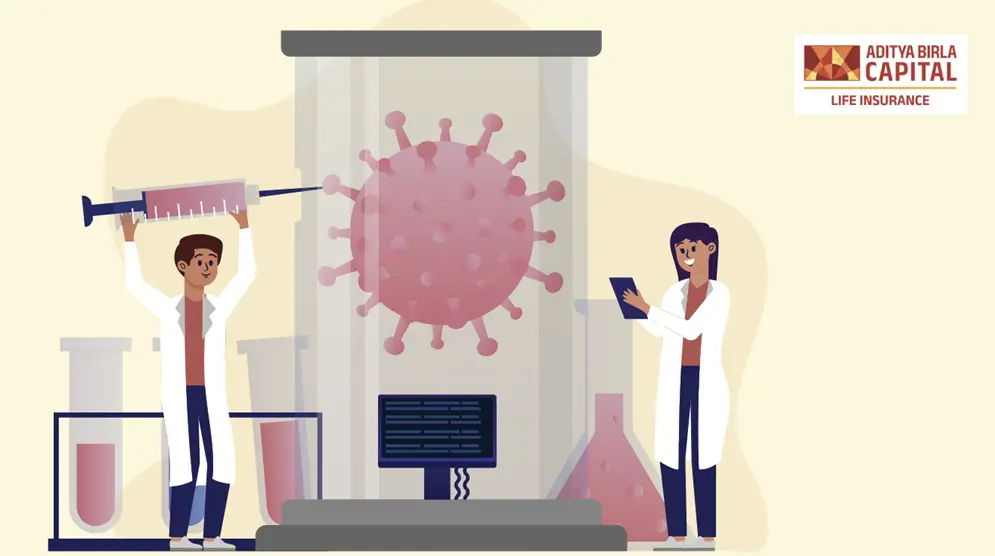Aditya Birla Sun Life Insurance Company Limited
What is Cancer Staging and its Different Techniques

Plan Smarter, Live Better!

Thank you for your details. We will reach out to you shortly.

Currently we are facing some issue. Please try after sometime.


- Table of Contents
Cancer is one of the most critical illnesses that wreaks havoc on lives worldwide. According to the World Health Organisation, cancer claimed nearly 10 million souls in 2020, which is a staggering number!1 Therefore, knowing the enemy's position in this relentless battle is absolutely necessary for defence. Enters cancer staging - the lifesaving GPS!
The way GPS helps in navigating unfamiliar roads, cancer staging pinpoints the exact location and the extent of the disease within your body. You can think of it as a crucial map that reveals the true nature of the disease and guides doctors to design the most effective treatment strategies. Armed with this knowledge, you can unleash a targeted attack on cancer, minimising the risks and maximising your chances of triumph.
In this article, we will explore what is cancer staging, the number of stages of cancer, and much more.
What Is Cancer Staging?
The term ‘cancer stage’ tells us how far the cancer has spread when it is first diagnosed. Knowing the stage of the disease is essential, as it helps to determine the most appropriate line of action for its treatment. The stage of cancer also gives an idea of how serious the disease is. Lower stages are usually easier to treat and have a better chance of recovery. On the other hand, higher stages can be more challenging to treat, and their impact on the person's health may be more severe. Hence, knowing the stage of cancer helps predict its current state and how serious it will get with time.
How Do Doctors Stage Cancer?
Doctors use various tests to figure out the extent of the disease. These include -
-
Physical Examination: Doctors check the person’s body for any signs of cancer.
-
Laboratory Examinations: Blood and urine samples are analysed for specific markers that may indicate the presence of cancer.
-
Biopsies: In this type of test, small tissue samples are taken from the affected area and examined to determine the presence of cancer cells.
-
Imaging Tests: Special scans like Magnetic Resonance Imaging (MRI), Computerised Tomography (CT), or Positron-Emission Tomography (PET) are used to create detailed pictures of the inside of the body.
These different types of tests help doctors see where the cancer is located in the body and how far it has spread.
When Is Cancer Staged?
Usually, the staging of cancer is done when it is initially diagnosed - before any treatment begins. However, in some cases, it is staged again after the treatment has started.
Now, let’s look at the different types of cancer staging -
-Clinical Staging
This type of staging is done before the cancer treatment begins. The doctor gathers information from various sources, such as physical exams, your medical history, x-rays, scans, and other tests you may have had. They also consider the results of any biopsies taken from the cancer, lymph nodes, or surrounding tissues. By doing this, the doctor can plan the best initial treatment for you.
-Pathological staging
Pathological staging is done based on the same information extracted from clinical staging. Additionally, the doctors also consider new insights gained from the surgery, if it was your first treatment.
-Post-Therapy Staging
Post-therapy staging is employed when cancer is not initially treated with surgery. In such cases, other treatments like radiation therapy or drug treatments such as chemotherapy, immunotherapy, or hormone therapy, are given before the surgery. These treatments help in shrinking the tumour, making it easier to remove it during surgery. And, they can also help doctors determine how well the treatments are working against cancer, which can pave the way for planning the further course of action.
Methods Used For Cancer Staging - How Many Cancer Stages Are There?
There are various ways to stage the cancer, such as -
-The TNM System
The most common method used for cancer staging is called the TNM system. It uses three letters, T, N, and M to describe the stage of cancer -
-T Stands For Tumour: The letter ‘T’ tells us the size and location of the tumour in your body. It is further categorised into numbers to give more details, such as -
○ TX: The main tumour cannot be measured. ○ T0: The main tumour cannot be found. ○ T1, T2, T3, T4: These numbers indicate the size and how far the tumour has grown into nearby tissues. The higher the number, the larger or more advanced the tumour. Sometimes, T is further divided into more specific categories like T3a and T3b to provide further information.
-
N Stands For Nodes: The letter ‘N’ tells us whether the cancer has spread to nearby lymph nodes and, if so, how many are affected. It is further divided into the following categories -
-
NX: The presence of cancer in nearby lymph nodes cannot be measured.
-
N0: No cancer is present in the nearby lymph nodes.
-
N1, N2, N3: These indicate the number and location of cancer in the lymph nodes. The higher the number after N, the greater the number of lymph nodes affected by cancer.
-
M Stands For Metastasis: The letter M tells the doctors the locations and the extent to which cancer has spread to other body parts, beyond its original location. It is further categorised using different numbers, like -
○ MX: Metastasis cannot be measured. ○ M0: The cancer has not moved to other parts of the body. ○ M1: Cancer has travelled from the original tumour and started growing in different areas.
-
Numeric Staging In addition to the letters TNM, cancer staging also includes numeric stages, which describe how advanced the cancer is. Let's break it down -
-
Stage 0: Also known as carcinoma in situ, this is the earliest stage of cancer. At this point, cancer cells are present only in the layer of cells where they started and have not invaded the nearby tissues yet.
-
Stage 1: These cancers are considered ‘early stage’ because they are small and haven't grown deeply into nearby tissues or spread to lymph nodes or other body parts.
-
Stages 2 and 3: These stages indicate that cancer has grown into the nearby tissues and also reached the lymph nodes, but has not spread to other body parts.
-
Stage 4: This is the most advanced stage, indicating that cancer has spread to other parts of the body. It is often called metastatic cancer because the cancer cells have travelled from the original site to other organs or distant locations.
Other Factors That Affect Staging
Here’s a list of some other additional factors that influence the stage of cancer -
- Grade
The grade of cancer, also known as differentiation, is a measure of how abnormal the cancer cells appear under a microscope. It is essential to know the grade of cancer because abnormal-looking cancer cells have a higher chance of growing and spreading to different body parts.
The grade of cancer is assigned a number. For instance, lower numbers like G1 are used to represent lower-grade cancers. Let’s understand the grades in detail -
-
Low-Grade (Well-Differentiated) Cancers: In these cancers, the cells look fairly normal. They tend to grow slowly and often have a better outlook for recovery.
-
High-Grade (Poorly Differentiated) Cancers: In these cancers, the cells look more abnormal. They often grow quickly and may require different treatments than low-grade cancers.
Even if the grade doesn't impact the cancer's stage, it still plays a role in determining the most suitable treatment and the outlook for the patient.
- Cell Type
The type of cell that makes up cancer can greatly impact its treatment and the overall outlook for the patient. For example, esophageal cancer can be squamous cell cancer or adenocarcinoma. Each of these types is assessed and treated differently based on their characteristics.
- Tumour Markers
These are substances found in high levels in the blood, tissue, or urine of a person with cancer. Interestingly, they can sometimes provide a more accurate prediction of how well a particular treatment will work for a specific cancer compared to its stage. For instance, let's consider prostate cancer in men. They have a high level of a specific marker called prostate-specific antigen (PSA) in their blood that can offer more valuable insights about cancer than traditional staging techniques.
- Tumour Location
In certain cancers, the location of the main tumour plays a crucial role in determining the prognosis or outlook for the patient. Therefore, it is taken into account during the staging process. For instance, In the case of oesophagal cancer, the stage is determined based on the location it started from - the upper, middle, or lower third of the oesophagus.
Conclusion
Cancer can be a life-threatening disease; however, if it is staged and treated on time, it can pave the way for the most effective treatment. Therefore, doctors employ a range of blood and urine tests and other scans, such as MRI, CT, PET, etc., to determine the stage of cancer. They also make use of methods like the TNM system, numeric staging, and other factors, such as the location of the tumour to find out the best course of action. The information obtained via these procedures can help you get a better chance to fight back, conquer, and embrace a brighter future.
Source
[1]https://www.who.int/news-room/fact-sheets/detail/cancer
Thank you for your details. We will reach out shortly.
Thanks for reaching out. Currently we are facing some issue.
Give ₹1,00,000 for 6 years
and Get ₹14.48 lakhs#
ABSLI Akshaya Plan
Whole Life Insurance with Cash Bonus
Flexible Bonus Payouts
Two options for benefit payouts
Life Cover
Tax Benefits
Give:
₹1 lakh for 6 years
Get:
₹14.48 lacs#
Most Popular Calculators
Most Read Articles
How to Calculate Gratuity for Private Sector Employees How to Calculate Gratuity for Private Sector Employees How to Calculate Gratuity for Private Sector Employees How to Calculate Gratuity for Private Sector Employees How to Calculate Gratuity for Private Sector Employees How to Calculate Gratuity for Private Sector Employees
Give ₹1,00,000 for 6 years
and Get ₹14.48 lakhs#
[1] https://www.who.int/news-room/fact-sheets/detail/cancer
ADV/2/24-25/2796







